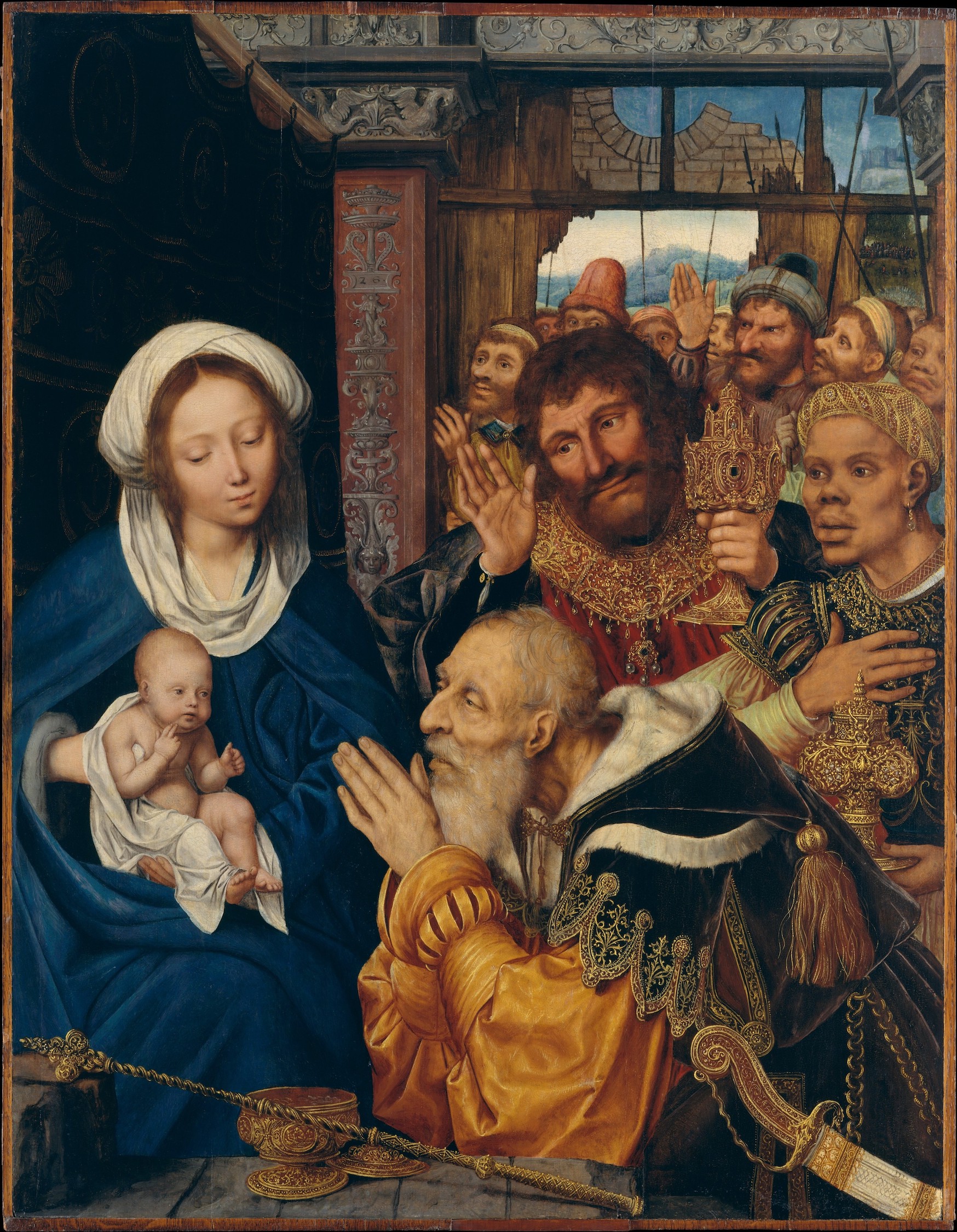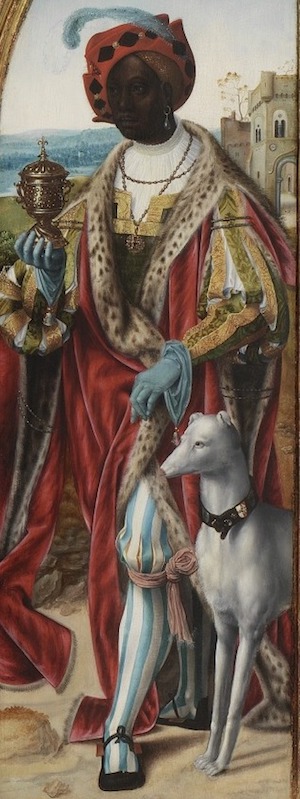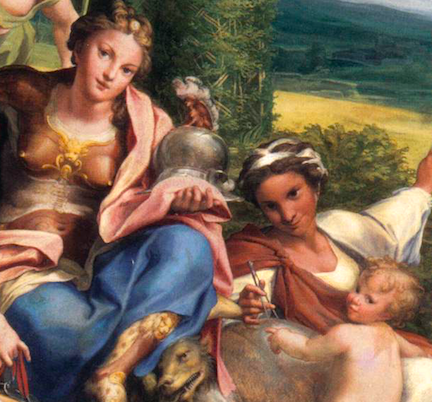Skin
“We couldn’t be more pleased with our black girl even if she was blacker…we think she’ll make the best buffoon in the world.”[35]
Isabella d’Este, letter to her Venetian agent
Georgio Brognolo, May 1491
Tonalities of the flesh were crucial to conceptions of race in sixteenth-century European contexts, as attested in this proclamation by Isabella d’Este (1474-1539), marchioness of Mantua. Some Black Africans with lighter skin were considered by white Europeans as more intelligent and civilized than Africans who were darker in complexion: they were often characterized as less than human, dangerous, and evil. When dark-skinned Black Africans were for sale in Italy, their prices fell significantly below those of lighter-skinned enslaved people, which McKee suggests means that they were not as much in demand as slaves from Central Asia or eastern Europe who had lighter skin.[36] Isabella d’Este’s characterization of her dark-skinned girl is symptomatic of this way of thinking: the deeper the tones, the more a “buffoon.”
Such ideas played out in visual representation in the theme of the Adoration of the Magi. The Gospel of Matthew 2:1-12 recounts that sometime after Christ’s birth, the Holy Family was visited by gift-bearing wise men or Magi. The Gospels do not specify the names of the Magi, but writers would later name them Balthazar, Caspar, and Melchior, representing Arabia, Persia, and India respectively. Balthazar eventually came to be depicted with a darker skin tone, with Africa rather than Arabia as his presumed place of origin. Paul Kaplan argued that this transformation was inspired by a desire to subsume African populations into the Western paradigm. The standardization of the black Magus would have been a convenient means of disguising and deflecting consideration of the moral and theological dilemmas posed by black slavery.[37] Such images, he concluded, would have allowed society to integrate foreign inhabitants of the non-European world into the Western Christian universe.[38] Albert Boime provided a necessary corrective about the motivations of such figures, for they suggested the Christianization of a “pagan” individual, and by extension of all those who shared his color, he states, “instead of missionaries and slavers invading the Black man’s land and plundering its wealth and subjugating its people by force, a noble and ‘wise’ black ruler comes of his own volition to the white man’s land and lays down his wealth and his power at the feet of the Christ child.”[39] Boime also notes that even with the depictions of where Balthazar is included, he is still generally placed behind the other two kings or further away from the holy infant. Furthermore, Alain Locke concluded that the black Magus tradition was a “romantic Christian myth” and in result, “was responsible for the first European art role of the Negro” and was the inclusion of the legendary blackamoor king among the Three Wise Men and that this very representation was the most artificial of all “Negro art stereotypes.”[40]
The blackness of Balthazar’s skin showed that he was from a distant land and symbolized Christianity’s attempts at global appeal to all of humanity, even the remote people. Some images of the Adoration of the Magi upheld racist hierarchies by representing the black Magus in ways that promoted stereotypes. In an example by the Netherlandish artist Quentin Metsys from 1526 (Fig. 5) the eldest of the Magi, Caspar, kneels with clasped hands and looks upon the baby Christ with reverent tenderness, while Balthazar and Melchior stand behind him, sharing a glance. Balthazar is shown dressed in an embellished outfit, holding a vessel containing a gift of liquid myrrh. He wears a large pearl-shaped earring and a decorated turban, which was often used to categorize an individual as exotic. The youngest Magus is often depicted in striped pants, another exotic signifier, as in Joos van der Beke van Cleve’s Adoration of the Magi (ca. 1525) (Fig. 6) or in Hans Baldung Grien’s painting of the same event (Fig. 7). The inclusion of Black Africans being represented as respected holy figures show the tolerance a white-skinned society could obtain by having a black magus and a St. Maurice because they represented an abstract piety.
(Fig. 7) Hans Baldung, The Three Kings Altarpiece, 1507. Linden panel. Staatliche Museen, Berlin.
Although northern European artists were producing depictions of Balthazar relatively frequently by the end of the fifteenth century, his figure was less often a subject of Italian Renaissance art, especially in central Italy. An unusual example is Andrea Mantegna’s Adoration of the Magi (1495–1505) (Fig. 8), in which the associations with Africa are apparent not only in Balthazar’s complexion and costume but also in the container he holds. The object appears to be made from alabaster, a semi-precious stone imported from Africa and highly valued by medieval and Renaissance Europeans. The black figure slightly blends into the dark background but is highlighted by his leopard-skin turban trimmed with orange cloth, and red lips from his agape mouth, which expose his teeth and tongue. From his ears dangle long pendants of pearls, similar to the one seen in Metsys’s painting of the same event (Fig. 5). Both images stereotyped Black Africans through the use of the pictorial conventions of the turban and earring.
(Fig. 9) Andrea Mantegna, The Adoration of the Magi (detail), 1460-64. Tempera on wood. Galleria degli Uffizi, Florence.
(Fig. 10) Andrea Mantegna, Judith with Her Maidservant with the head of Holofernes,1492. Ink on paper. Uffizi Gallery, Florence.
Mantegna completed several works that included Black Africans while he was employed as an official court painter to Isabella d’Este and her husband Francesco II Gonzaga. Those works included The Adoration of the Magi (1460-64) (Fig. 9), Judith and her maidservant with the head of Holofernes (1491-92) (Fig. 10 ), and Ceiling Oculus (1465-74) (Fig. 11). It has been well documented that Isabella and Francesco owned Black African slaves and servants: Isabella and members of her family are the best-known examples of fifteenth-century patrons who keenly sought and had to make considerable efforts to find captive Black African children to add to their collection of objects of curiosity. Isabella’s sensitivity to flesh tones, and by extension their significance to Renaissance culture, is revealed in her request for the purchase of a little girl who was “as black as possible” (as mentioned above). With this historical context in mind, it is plausible that Mantegna’s Adoration of the Magi (Fig. 8) was informed by enslaved peoples in Isabella’s household. As McKee argued, “the scarcity of Black Africans in Italian cities undoubtedly reinforced the exotic quality that some contemporary Italians attributed to them. Nevertheless, their visibility in the art of the period suggests that they were few enough to be exotic but common enough not to look out of place as servants in a painting.”[41]
Paul Kaplan argues that Isabella d’Este and Andrea Mantegna created a new iconographic type: the black attendant to a white European protagonist.[42] In his opinion, Mantegna’s depictions of Judith’s servant was depicted as Black for the first time by Mantegna in a drawing in 1492 (Fig. 10). As the author points out, this idea of displaying black servants to suggest the universal reach of imperial power had already been developed, by Frederick II. Kaplan stresses the diffusion of this idea among European rulers, in which black servants, specifically darker-skinned, were used to depict universal reach of imperial power.[43] Correggio’s painting Allegory of Virtues (1523-30) (Fig. 12) depicts a young Black woman that Kaplan concludes was purchased by Isabella d’Este in 1522.[44] The Sforza court in Milan was also very attracted to the visual depictions of their Black servants. By the 1490s Lodovico ‘il moro’ Sforza (1452-1508), his courtiers, and political allies, used actual and fictive black servants as emblems of the duke’s nickname.[45] Her lighter skin was considered beautiful by European Renaissance standards. There was a growing presence of Black girls and women in Italy which, in many respects, made them a desirable commodity. The young girl had been “recently captured, 16 or 17 years of age, beautiful, with the exception that her lower lip was thick.”[46] Isabella had bemoaned the “difficulty of finding in this area a moor of this age.”[47] Perhaps she sought African children in particular, whether directly from orphanages or enslaved from Africa, because the younger the enslaved children were, the more “appreciated” they were; they were also more susceptible to instruction and therefore likely more compliant.[48]








